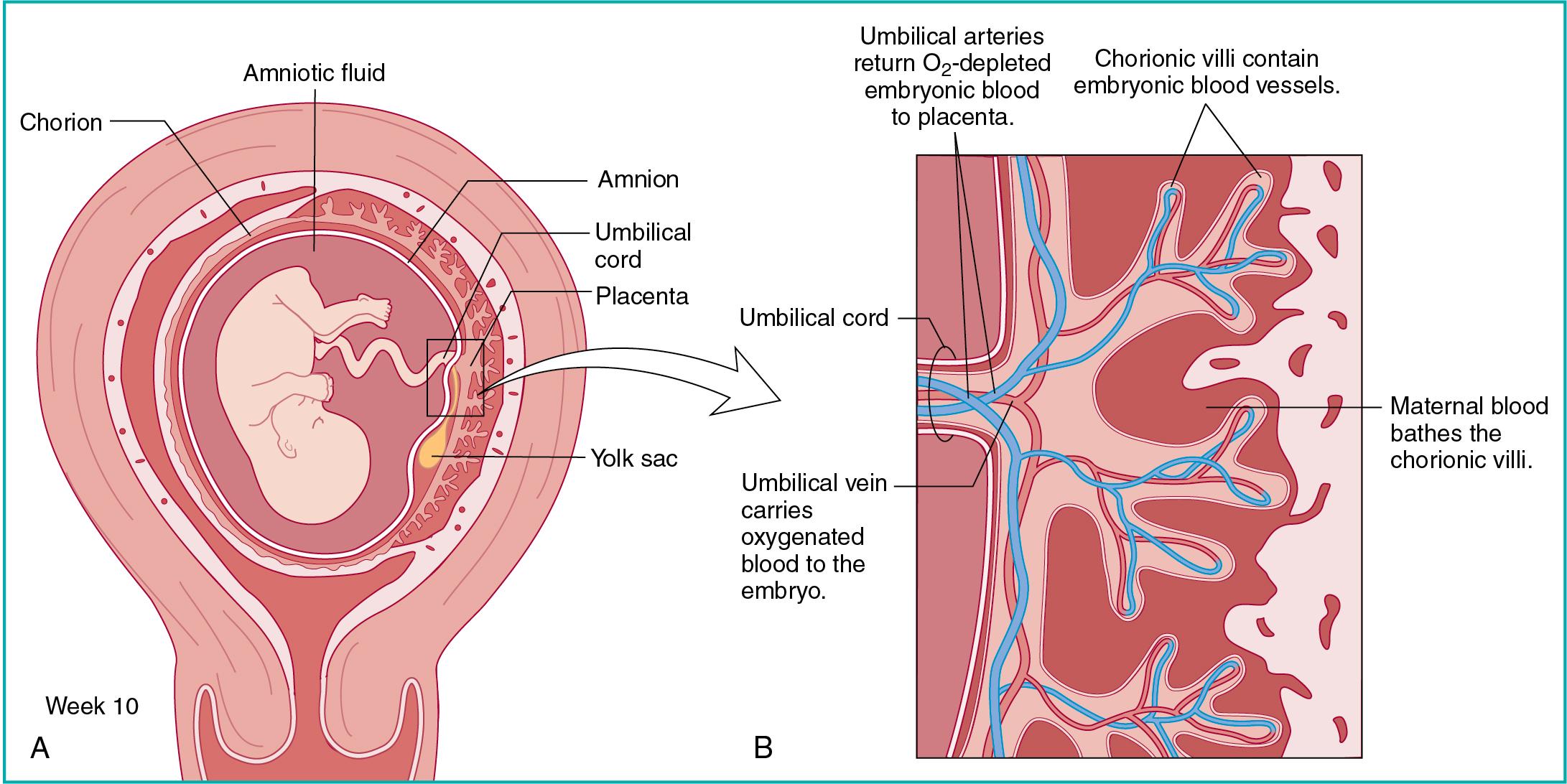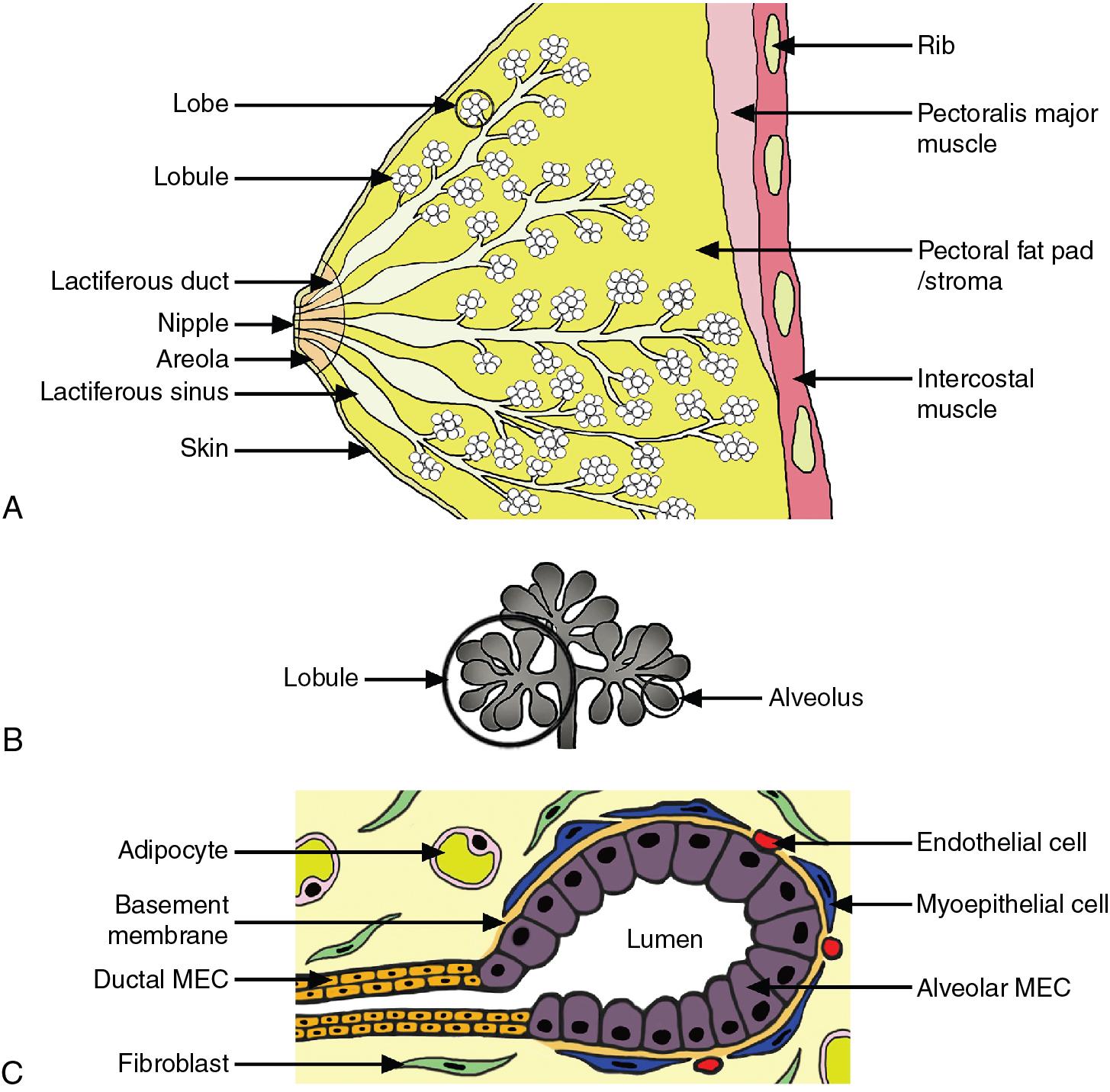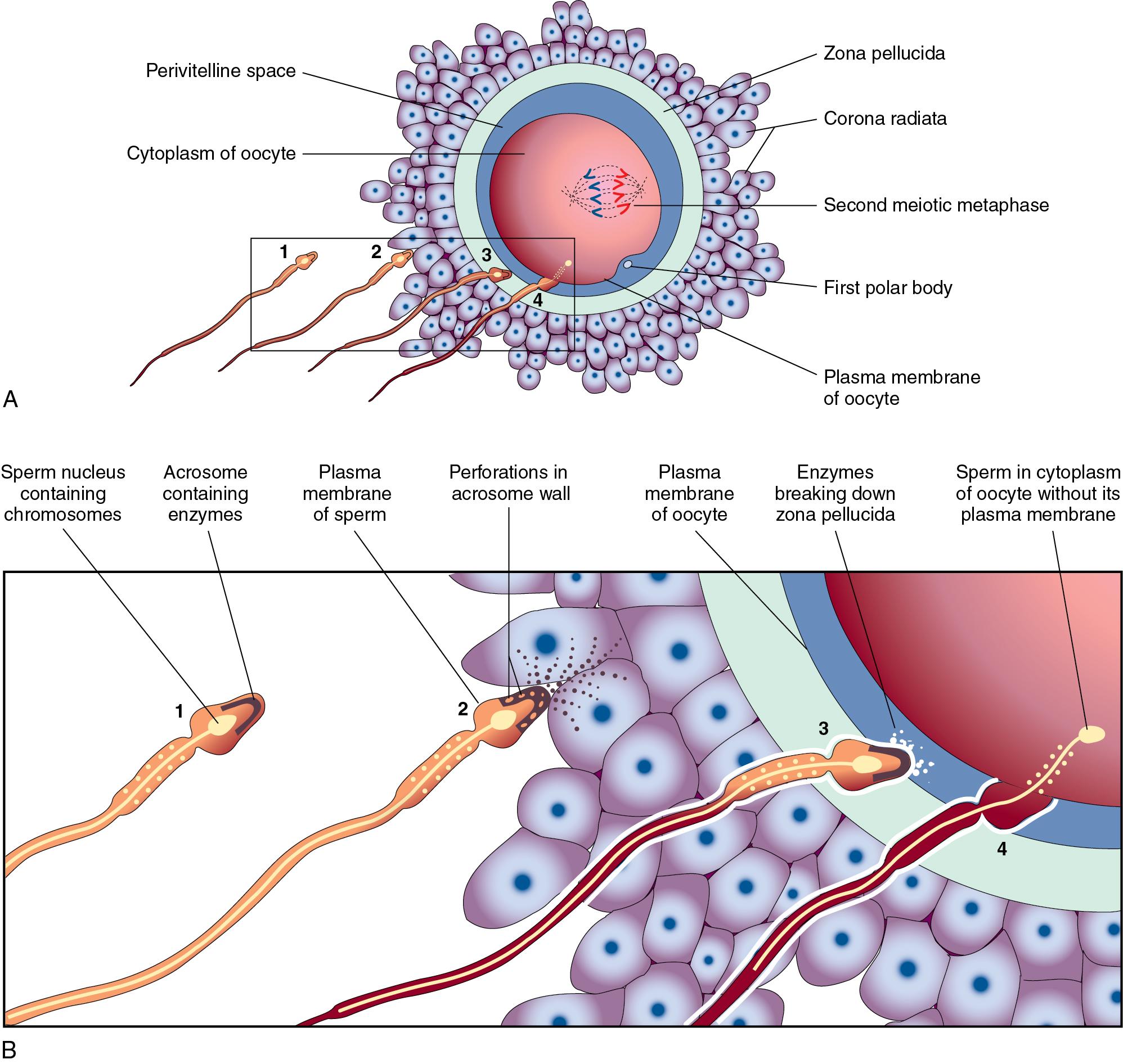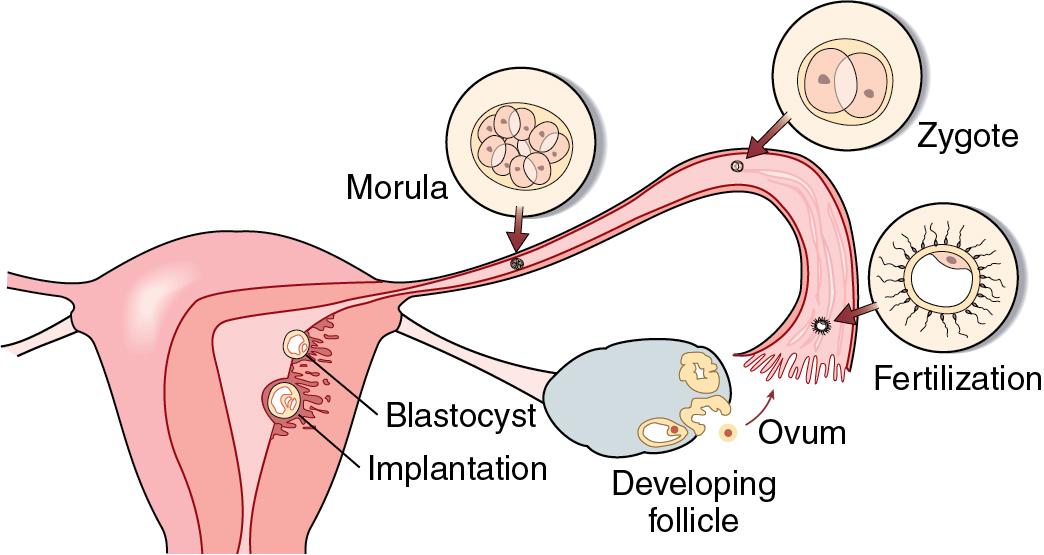Physical Address
304 North Cardinal St.
Dorchester Center, MA 02124
The placenta serves as the point of exchange between the circulatory systems of the mother and fetus; it is also a hormone-producing organ ( Fig. 35.1 A).
The fully developed placenta is a round oval organ 15 to 20 cm in diameter and 2 to 3 cm thick, embedded in the uterine wall.
It connects to the developing fetus via the umbilical cord and is expelled during birth.
The placenta is composed of segments called cotyledons. Fingers of placental tissue (chorionic villi) extend into a pool of arterial maternal blood in the uterine wall, the intervillous space ( Fig. 35.1 B).
The intervillous space is supplied by uterine spiral arteries, which have developed under the influence of progesterone.
Bathed in the maternal blood of the intervillous space, the fetal capillaries of the villi passively absorb oxygen and nutrients and pass carbon dioxide and waste products into the maternal blood.
The intervillous blood then drains back into the maternal circulation through the uterine veins in the decidua basalis.

The outer sheath of the villi is a layer called the chorion, which is composed of trophoblast cells. The chorionic barrier between the fetal villous blood and the maternal intervillous blood blocks the passage of most cells and large proteins.
The barrier blocks peptide hormones but does allow the passage of steroid hormones.
The chorion not only covers the villi but also extends beyond the placenta to envelop the entire amnion, the sac that contains the developing fetus in its amniotic fluid.
After a baby is born, the mother’s body can continue to provide nourishment via the paired milk-producing mammary glands, or breasts ( Fig. 35.2 ).
The breasts are composed mainly of adipose and connective tissue.
The mammary glandular tissue is divided into 15 to 20 lobules arranged in a radial pattern around the areola of the nipple.
Each lobule connects to the outside world through a network of lactiferous ducts.
The lactiferous ducts merge with each other as they approach the nipple, and there are about 5 to 10 duct openings on the nipple surface.
The lobules are composed of individual mammary alveoli. Each alveolus is lined with epithelial cells and a sublayer of myoepithelial cells.
Lymphatic drainage from the breast is mainly to the axillary lymph nodes.

Recall that human chorionic gonadotropin (hCG) maintains the corpus luteum and progesterone production. hCG is a heterodimeric glycoprotein synthesized and secreted by trophoblast cells of the placenta.
Like luteinizing hormone (LH), follicle-stimulating hormone (FSH), and thyroid-stimulating hormone (TSH), hCG has an alpha and a beta subunit.
The alpha subunit has the same amino acid sequence as that of LH, FSH, and TSH.
The beta subunit is almost identical to that of LH but differs by having 31 extra amino acids at the carboxy terminus.
hCG differs from the other three hormones in the number and type of carbohydrate side chains on the polypeptide subunits. Because hCG is more heavily glycosylated than LH, FSH, and TSH, it has a much longer half-life.
Relaxin, a polypeptide hormone secreted by the ovaries and other tissues, is active in many of the structures of pregnancy. It functions to relax the birth canal by proliferative effects on the surrounding tissues, which facilitates the delivery of a baby.
Relaxin likely also acts through a nitric oxide-mediated mechanism to depress intestinal motility (which may be the reason for many of the gastrointestinal symptoms of pregnancy) and decreases blood vessel tone.
Prolactin is a polypeptide hormone synthesized and secreted by lactotroph cells in the anterior pituitary (see Clinical Correlation Box 35.1 ):
It is structurally similar to growth hormone, as is its receptor.
Breast tissue alveolar epithelial cells have prolactin receptors.
Oxytocin is a peptide product of hypothalamic magnocellular neurons and is released from the posterior pituitary.
The cell bodies of the magnocellular neurons are located in the hypothalamic supraoptic and paraventricular nuclei.
After production in these cell bodies, the oxytocin is packaged into secretory granules, transported down the axons within the infundibular stalk, and secreted at the axon terminals within the posterior pituitary.
Oxytocin receptors are found on uterine myometrial cells and breast tissue myoepithelial cells. Oxytocin stimulates uterine contraction, and uterine contractions stimulate the release of additional oxytocin. This demonstrates a positive feedback loop that expedites parturition. But early in pregnancy, when parturition is not desirable because the fetus is not yet viable outside of the mother’s body, a placental enzyme called oxytocinase, which also functions as a vasopressinase, inhibits the effects of oxytocin. However under circumstances such as a large placenta with multiple gestations the same enzyme can degrade arginine vasopressin, leading to large amounts of free water excretion in the urine of the mother, a condition known as diabetes insipidus of pregnancy.
Human chorionic somatomammotropin (hCS), also called human placental lactogen (hPL), is another protein hormone synthesized and secreted by the placenta. It strongly resembles prolactin and growth hormone and mimics their effects in the mother’s body.
The prostaglandins are a family of related molecules derived from arachidonic acid. Among the many members of this family, prostaglandins E2 (PGE 2 ) and F 2 α (PGF 2 α) are important in labor.
Tumors which block the pituitary stalk and prevent the flow of dopamine from the hypothalamus to the anterior pituitary may result in hypooestrogenism with anovulatory infertility and a decrease in menstruation in women because of increased prolactin levels. Many women with hyperprolactemia also experience loss of libido, breast pain, and galactorrhea (breast milk production), and vaginal dryness.
If pregnancy is achieved, the female reproductive system changes dramatically. The ovaries and uterus abandon their monthly cycles and instead promote:
Growth of the fetus.
Changes in the pelvis necessary to facilitate delivery.
Development of the breasts necessary for lactation, or milk production, during the postpartum period, the period of time after birth.
Fertilization may result from sexual intercourse between a male and female. In males and females, sexual intercourse is preceded by the condition of libido or desire, which leads to arousal or excitement in a sexual encounter. In the female, the excitement and plateau phases involve secretory lubrication of the vagina and elevation of the uterus in the pelvis. Orgasm is associated with spasm of the vaginal walls. Females can usually achieve arousal again shortly after orgasm, unlike males, who have a refractory period that increases with age.
Once ejaculated, sperm must undergo capacitation—cytologic changes that prepare the sperm for fusion with an egg—which occurs within the female reproductive tract and takes more than 1 hour.
Capacitated sperm can last up to 2 days in the female reproductive tract, but for fertilization to occur, sperm must reach the oocyte within 24 hours of ovulation.
Pregnancy begins with a spermatozoon’s fertilization of a secondary oocyte—an ovulated oocyte arrested in metaphase II of meiosis.
The sperm swim from the vagina, through the cervix and uterus, and into the fallopian tube, where they encounter or wait for the oocyte in the ampulla.
Estrogen-dependent proliferative-phase changes in the female reproductive tract encourage the sperm’s progress:
Vaginal glycogen production acidifies the vagina and enhances sperm motility.
Watery cervical fluid promotes the sperm’s passage, as does the enhanced contractility of the myometrium.
Still, only one sperm in about a million reaches the ampulla. Shortly before or after the sperm’s arrival, the oocyte is waved into the ampulla by the cilia lining the fallopian tube.
Each sperm cell in the ampulla penetrates the outer shell of the secondary oocyte, the corona radiata, by driving forward with flagellar movements. When one reaches the zona pellucida, a glycoprotein in the zona triggers the release of proteolytic enzymes from the acrosome, or head of the sperm ( Fig. 35.3 ).
The enzymes break down the zona and the sperm drives into the oocyte.
Once a single sperm makes it through the zona pellucida, cortical granules in the oocyte release proteases in what is called the zona reaction and render the zona impenetrable to other sperm, thus ensuring that only one sperm fertilizes the egg.

Once inside the zona pellucida, the cell membranes of the sperm and egg fuse, making their cytoplasm continuous.
This stimulates the nucleus of the secondary oocyte to exit its meiotic arrest and complete meiosis II, forming the mature haploid ovum and casting off a polar body.
The nuclei of the mature ovum and the spermatozoon then fuse, forming a zygote with 46 chromosomes.
Once the zygote begins to divide, it is called an embryo. The embryo slowly drifts down the fallopian tube, dividing as it travels, and enters the uterus approximately 3 days after fertilization. Although it increases in cell number along the way, it does not increase in size, which prevents it from becoming stuck in the fallopian tube.
By the time it reaches the uterus, the embryo consists of about 12 cells clustered into a ball and is called a morula ( Fig. 35.4 ).

After another 3 days, the morula then develops into a blastocyst, an asymmetric ball of cells with a fluid-filled cavity inside, before it implants into the wall of the uterus.
Thus the time from fertilization to implantation in the uterus is about 6 days.
Some of the cells of the blastocyst differentiate and grow into the maternal endometrial tissue.
This invasion of fetal tissue into the endometrium is called implantation.
The embryonic cells that invade the endometrium are known as trophoblasts. Importantly, it appears that the trophoblasts lack the major histocompatibility complexes by which a maternal immune response could be mounted against the foreign embryonic tissue.
Soon after implantation, the trophoblasts begin to produce hCG to maintain the corpus luteum.
The placenta is a transient organ derived from embryonic tissue, which:
Serves as the site of exchange between maternal and fetal circulations.
Secretes hormones that maintain pregnancy.
Synthesized de novo: hCG and hCS.
Converted from maternal cholesterol: Progesterone.
Converted from fetal adrenal androgens: Estrogens.
Become a Clinical Tree membership for Full access and enjoy Unlimited articles
If you are a member. Log in here